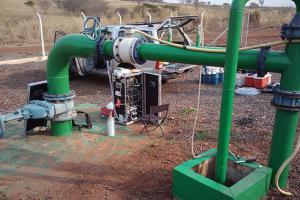Coastal infrastructureGroundwater extraction contributes less to sea level rise than previously thought
Groundwater extraction and other land water contribute about three times less to sea level rise than previous estimates, according to a new study. The study does not change the overall picture of future sea level rise, but provides a much more accurate understanding of the interactions between water on land, in the atmosphere, and the oceans, which could help to improve future models of sea level rise.

Water extraction facility // Source: udel.edu
Groundwater extraction and other land water contribute about three times less to sea level rise than previous estimates, according to a new study published in the journal Nature Climate Change. The study does not change the overall picture of future sea level rise, but provides a much more accurate understanding of the interactions between water on land, in the atmosphere, and the oceans, which could help to improve future models of sea level rise.
“Projecting accurate sea level rise is important, because rising sea level is a threat to people who live near the ocean and in small islands,” explains IIASA researcher Yoshihide Wada, who led the study. “Some low-lying areas will have more frequent flooding, and very low-lying land could be submerged completely. This could also damage substantially coastal infrastructure.”
IIASA notes that sea level has risen 1.7 mm per year over the twentieth and the early twenty-firstt century, a trend that is expected to continue as climate change further warms the planet. Researchers have attributed the rising seas to a combination of factors including melting ice caps and glaciers, thermal expansion (water expands as it gets warmer), and the extraction of groundwater for human use.
Land water contributions are small in comparison to the contribution of ice melt and thermal expansion, yet they have been increasing, leading to concerns that this could exacerbate the problem of sea level rise caused by climate change.
However, much uncertainty remains about how much different sources contribute to sea level rise. In fact, sea level has actually risen more than researchers could account for from the known sources, leading to a gap between observed and modeled global sea-level budget.
Previous studies, including estimates used in the IPCC Fifth Assessment Report, had assumed that nearly 100 percent of extracted groundwater ended up in the ocean. The new study improves on previous estimates by accounting for feedbacks between the land, ocean, and atmosphere. It finds that number is closer to 80 percent. That means that the gap between modeled and observed sea level rise is even wider, suggesting that other processes are contributing more water than previously estimated.
“During the twentieth century and early twenty-first century, cumulative groundwater contribution to global sea level was overestimated by at least 10 mm,” says Wada. In fact, the new study shows that from 1971 to 2010, the contribution of land water to global sea level rise was actually slightly negative – meaning that more water was stored in groundwater and also due to reservoir impoundment behind dams. From 1993 to 2010, the study estimates terrestrial water as contributing positive 0.12 mm per year to sea level rise.
IIASA notes that the study does not change the fact that future groundwater contribution to sea level will increase as groundwater extraction increases. And the increasing trend in groundwater depletion has impacts beyond sea level rise. Wada explains, “The water stored in the ground can be compared to money in the bank. If you withdraw money at a faster rate than you deposit it, you will eventually start having account-supply problems. If we use groundwater unsustainably, in the future there might not be enough groundwater to use for food production. Groundwater depletion can also cause severe environmental problems like reduction of water in streams and lakes, deterioration of water quality, increased pumping costs, and land subsidence.”
— Read more in Y. Wada et al., “Fate of water pumped from underground and contributions to sea-level rise,” Nature Climate Change (2 May 2016) (doi:10.1038/NCLIMATE3001)
